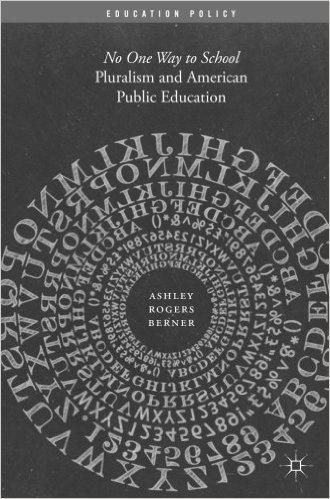Pluralism and American Public Education: No One Way to School
by Ashley Rogers Berner
(Basingstoke, United Kingdom: Palgrave Macmillan, 2016).
“We should stop sentimentalizing the traditional public school and open ourselves to a different way of doing public education,” writes Ashley Rogers Berner in her invigorating and highly readable new book, Pluralism and American Public Education: No One Way to School. “There is nothing to fear and much to gain from doing so.”
 Berner, the Deputy Director of the Institute for Education Policy at Johns Hopkins, where she is also an assistant professor, traces much of our educational malaise to a pair of historical “wrong turns”: the nineteenth century decision to impose a uniform structure on American education, and the abandonment of a traditional academic curricula. As a result of these twin sins, the majority of our children attend geographically determined, state-run schools. And the majority of those aren’t very good.
Berner, the Deputy Director of the Institute for Education Policy at Johns Hopkins, where she is also an assistant professor, traces much of our educational malaise to a pair of historical “wrong turns”: the nineteenth century decision to impose a uniform structure on American education, and the abandonment of a traditional academic curricula. As a result of these twin sins, the majority of our children attend geographically determined, state-run schools. And the majority of those aren’t very good.
The book’s strength is its systematic dismantling of the most common arguments against pluralism and the “political arrangement” that privileges state-run schools and entrenches mediocrity, particularly for our neediest students. Only state schools can create good citizens? Wrong. “Longstanding research suggests that private schools, particularly Catholic ones, often provide better civic preparation than public schools,” Berner counters. Private education worsens inequity? Nonsense. Non-public schools have shown more success than traditional public schools in closing achievements gaps. What about the separation of church and state? The Supreme Court has held that when public funding for religious schools is the result of free parental choice, not state coercion, it passes Constitutional muster. Case closed.
Most interestingly of all, it turns out that America’s fondness for a uniform, state-run system of public schools makes us something of an outlier, Berner reports. In a host of countries, the state “either operates a wide array of secular, religious, and pedagogical schools, or it funds all schools but operates only a portion of them,” she writes. These countries’ systems are not intended to be uniform; they are pluralistic by design. Moreover, she argues, the absence of educational pluralism on our shores is, well, un-American. State-sponsored uniformity is not merely problematic for depressing academic outcomes “but also for its incongruity with American principles of freedom,” Berner observes.
At this point, free-market libertarians are likely nodding their heads and thinking, “You tell ‘em, Dr. Berner!” Not so fast. While libertarian organizations have been “tireless supporters of school choice,” that support often comes with wariness about state power, she notes. Meaningful diversification of schools could be harmed by “the libertarian resistance to government, period.” Pluralism requires “meaningful government regulation of non-public schools,” but this oversight should be “loose instead of tight, focused on academic standards and performance rather than on school culture,” she argues. “But some will chafe at this.”
This reviewer included. Berner commits a sin of omission in eliding the deleterious effects of muscular accountability on the plural system of schools she rightly valorizes. Berner may indeed be correct to argue that “making educational pluralism the norm as opposed to the exception…requires creating authoritative institutions that have moral ballast.” But when a governmental authority dictates exclusively what is measured and the expected outcomes, it exerts an irresistible influence on classroom practice, fundamentally altering the curriculum and culture. Let a thousand flowers bloom, but first get those reading scores up! In Berner’s defense, this may be a uniquely American problem. “Countries with plural systems do not tend to pit one school sector against another by comparing outcomes in Jewish, Catholic, Montessori, and state schools to assess the merits of each type,” she notes. Quality control, this implies, needn’t be synonymous with competition.
Berner’s thoughtful and persuasive book could not be more perfectly timed or attuned to the moment. As she observes, many districts and states have been moving in the direction of educational pluralism for some time via vouchers, charter schools, tax credits, and education savings accounts. “But cultural expectations die hard,” she writes. With the arrival of the pro-school choice duo of President Trump and Betsy DeVos, his designated Education Secretary, the age of American educational pluralism—if there is ever to be one—may be at hand. Berner’s book could be its bible.
—Robert Pondiscio
Robert Pondiscio is senior fellow and vice president for external affairs at the Thomas B. Fordham Institute.
This post originally appeared on Flypaper.


